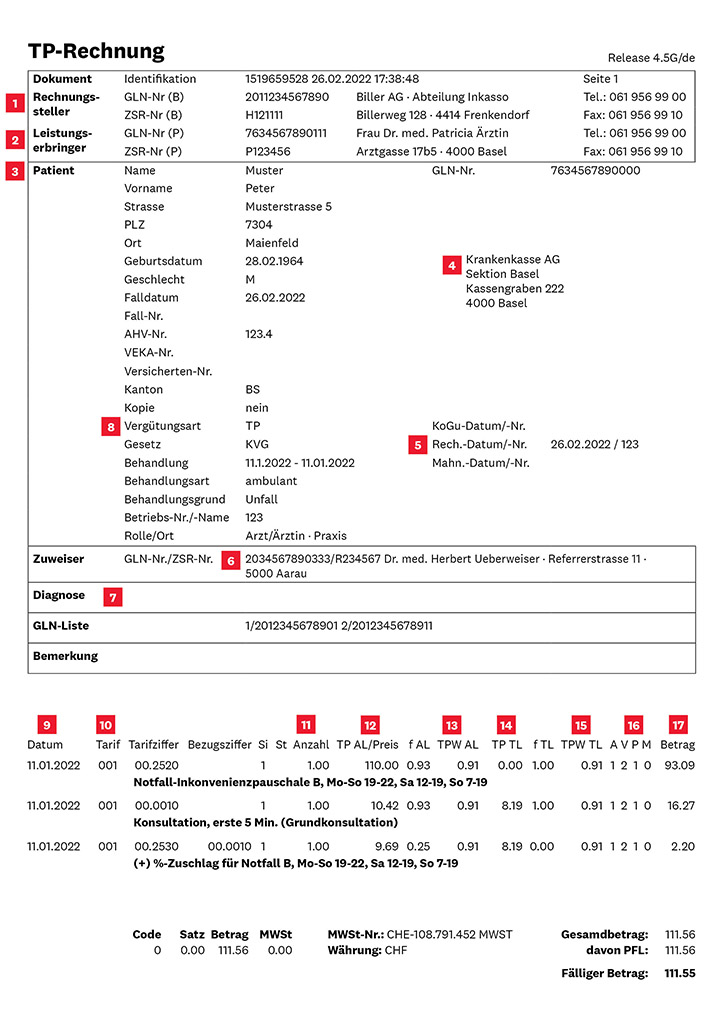Checking medical bills made easy
What does everything mean in the doctor’s bill?
Numbers, codes, abbreviations: Doctors’ bills are pretty technical and not self-explanatory. They are primarily used for payment processing between service providers (such as doctors’ surgeries, hospitals, therapists) and health insurance companies. We still recommend that you check them. You can find out here how a doctor’s bill is put together.
Good to know: As soon as Sympany receives a bill for you from a service provider, you’ll find it in the mySympany customer portal. You can report any discrepancies directly to us via a message in mySympany – or of course also by other means. Contact with customer service >
Only you know whether you were undergoing treatment during the period indicated on the bill, whether the examinations stated were actually carried out and whether, for example, the number of billed medications is correct. Sympany cannot assess this. It might occur that an invoice is mistakenly incorrect – however, there are (rare) cases of malpractice (such as incorrectly charged COVID-19 tests during the pandemic).
Of course: Invoice verification is a key task of the health insurance companies and across the industry leads to savings of more than 3 billion Swiss francs per year, which has a direct impact on the premium. For example, it is checked whether the correct tariff has been billed. Invoices that have been incorrectly billed or are conspicuously high will be rejected.
Explanation: How doctors’ bills are put together
► The information you can check easily is marked with an arrow.

| 1–6 |
Personal data. The addresses of you and your doctor are shown here. ► Is this data correct? Were you treated by the doctor specified? |
| 7 | Diagnosis. The diagnosis is specified by a capital letter and a number and it is kept very general. You can find out here what the codes stand for: Diagnosis code for outpatient treatments (PDF, in German) > |
| 8 |
Tiers garant (TG): The insured person pays the bill and claims the money back from the health insurer. Tiers payant (TP) means that the bill goes directly to the health insurer. You will find it in mySympany as soon as we receive it, but your service provider is also obliged to send you a copy. |
| 9 |
Treatment data, including telephone consultations. ► Is the data correct? Were you undergoing treatment during the specified period or did you have a telephone consultation? Please note: Services can also be charged in the absence of the patient (such as reading files, clarification with other service providers, compiling reports, etc.). If you are uncertain, you can check with your service provider. |
| 10 |
Code of the tariff used. 001 stands for TARMED, 400 for list of pharmaceutical specialities. TARMED lists around 4,600 medical services. The list of pharmaceutical specialities contains all medications that are paid by the basic insurance. In addition, there are a number of other tariff lists. ► Good to know: You can enter the tariff number in the Tarmed browser (in German). Under “Medizinische Interpretation” (Medical interpretation) there is a breakdown of what is included in this item. |
| 11 |
Quantity charged per tariff item. This indicates the number of times a service was provided. ► The number of medications is easy to check. You can decode the duration of the consultation as follows: 00.0010 stands for the first five minutes, 00.0020 for all following five minutes and 00.0030 for the last five minutes. Important: Reading and updating the patient’s file is also charged. So if your consultation was 20 minutes long but you have been charged for 40 minutes, this might well be correct. If you feel the time specified is too long, you can check with your service provider. |
| 12 | Tariff point (TP) of medical service. For each service, the same number of tariff points are billed all over Switzerland. |
| 13 | Tariff point value of medical service. The tariff point value differs from one canton to another. If you multiply the tariff point by the tariff point value, you will get the price of the underlying medical service (AL). |
| 14 | Tariff point of technical service (TL). This reimburses the costs for the infrastructure, such as rent, electricity and cleaning as well as non-medical staff (practice assistants). This is the same all over Switzerland. |
| 15 | Tariff point value of technical service. This is the same amount as for the medical service (AL). |
| 16 | Obligatory service code. The column P is important. Here, the doctor indicates whether, from his/her perspective, this was an obligatory service or not. The meaning of the number depends on which software was used for billing. You will find the reference to this in the top right-hand corner of the bill. In Release 4.2 or earlier, a 0 means that the basic insurance must take over the costs; a 1 on the other hand indicates a non-obligatory service. From Release 4.3, it’s the other way round: Here, 0 indicates a non-obligatory service and 1 an obligatory service. |
| 17 | Total amount of an individual service (tariff item). This is made up of: Tariff point of the medical service × tariff point value of the medical service + tariff point of the technical service × tariff point value of the technical service. |
| 18 | Total amounts of the individual areas such as medical services, technical services, medications or list of medical supplies and devices. The list of medical supplies and devices contains everything which the patient can use to examine, treat or support themselves at home, from blood glucose strips to ventilation equipment and crutches. The basic insurance pays everything listed in the list of medical supplies and devices. |
| 19 | Total of bill |